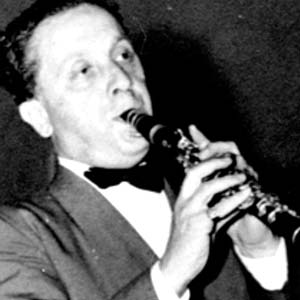Dave Tarras (1895 – February 13, 1989) was possibly the most famous 20th century klezmer musician. He is known for his long career and his very skilled clarinet playing.
Tarras, born Dovid Tarraschuk in Ternivka, (a village in Teplytskyi Raion, Vinnytsia Oblast, Ukraine), was the son of a klezmer trombonist and Badkhn. He grew up playing a variety of instruments and surrounded by the music. He was conscripted into the tsar’s army in 1915, but his talents as a musician kept him out of the trenches. In 1921 he emigrated to New York City, where worked in a garment factory for a time.
Eventually he found he could make money as a musician, and worked as a clarinetist in many of New York’s klezmer ensembles. In addition to Jewish music, he also recorded Greek, Polish and Russian tunes. His ability to play different styles was further masked by the use of pseudonyms on his recordings for Columbia Records. It is conservatively estimated that he participated in 500 recordings during his career.
His skill and reliability enabled him to play for many years longer than the other klezmer pioneers of his day (Naftule Brandwein, for example had retired or left the business). Tarras’ experience playing in the czarist military band, his ability to read music, and his excellent command of the Yiddish style made him a favorite among bandleaders. After klezmer music fell out of fashion following World War II, Tarras remained one of the few musicians to still record and play actively. His style has been characterized as smooth and dignified, with deliberate and rhythmical phrasing. His personal repertoire came from his Bessarabian roots and the influences of Jewish and Gypsy (Roma) music. Zev Feldman has credited Tarras with not only “Bessarabianizing” Jewish dance music, but also with replacing what had been the dominant tune style of the freylekh with the Bulgar.
Tarras’ most enduring recording, Tanz! (1956) was the brainchild of his son-in-law, clarinetist and saxophonist Sam Musiker. The album, which successfully combines jazz and klezmer idioms, was not well received in its day, but remains central to the canon of present-day revivalists.
At the beginning of the klezmer revival in the 1970s and 80s, Tarras mentored many young musicians who went on to become famous, including mandolinist Andy Statman.
Tarras died in 1989 in Oceanside, Nassau County, New York. He left a daughter, Broune, a son, Seymour, and seven grandchildren.
He is the subject of a recent biography by Yale Strom, Dave Tarras – The King of Klezmer.


10 thoughts on “Kaminos”
Was Nicholas related to Alexander Saslavsky who married Celeste Izolee Todd?
Anyone have a contact email for Yair Klinger or link to score for Ha-Bayta?
wish to have homeland concert video played on the big screen throughout North America.
can organize here in Santa Barbara California.
contacts for this needed and any ideas or suggestions welcomed.
Nat farber is my great grandpa 😊
Are there any movies or photos of max kletter? His wife’s sister was my stepmother, so I’m interested in seeing them and sharing them with his wife’s daughter.
The article says Sheb recorded his last song just 4 days before he died, but does not tell us the name of it. I be curious what it was. I’d like to hear it.
Would anyone happen to know where I can find a copy of the sheet music for a Gil Aldema Choral (SATB) arrangement for Naomi Shemer’s “Sheleg Al Iri”. (Snow on my Village)?
Joseph Smith
Kol Ram Community Choir, NYC
שלום שמעון!
לא שכחתי אותך. עזבתי את ישראל בפברואר 1998 כדי להביא את בני האוטיסט לקבל את העזרה המקצועית שלא הייתה קיימת אז בישראל. זה סיפור מאוד עצוב וטרגי, אבל אני הייתי היחיד עם ביצים שהביא אותו והייתי הורה יחיד בשבילו במשך חמישה חודשים. הוא היה אז בן 9. כעת הוא בן 36 ומתפקד באופן עצמאי. נתתי לו הזדמנות לעתיד נורמלי. בטח, אבות כולם חרא, אומרים הפמינציות, אבל כולם צריכים לעבוד כמטרות במטווחי רובה!
משה קונג
(Maurice King)
Thank you for this wonderful remembrance of Herman Zalis. My late father, Henry Wahrman, was one of his students. Note the correct spelling of his name for future reference. Thank you again for sharing this.
Tirza Wahrman (Mitlak)
amazing zchuso yagein aleinu, he wrote the famous niggun Lefichuch that is sung in almost every Israeli Yeshiva